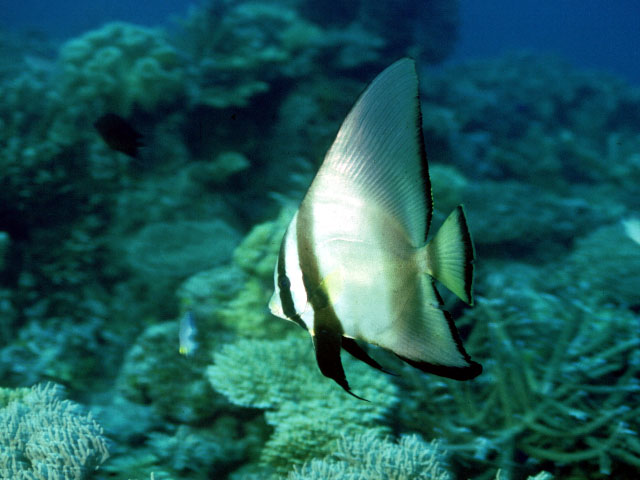| Ephippidae (Spadefishes, batfishes and scats) |
| 45 cm TL (male/unsexed) |
|
reef-associated; marine; depth range 15 - 30 m |
| Western Pacific: Ryukyu Islands to Australia. Occurrence of this species in the Indian Ocean is doubtful. |
|
Dorsal spines (total): 5-6; Dorsal soft rays (total): 34-37; Anal spines: 3-3; Anal soft rays: 24-28. Juveniles are dark brown to black with a brilliant crimson margin around the entire fish (Ref. 1602). Adults dull silver with short fins (Ref. 1602). Body orbicular and strongly compressed, its depth more than twice length of head and 0.9 to 1.3 times in SL. Head length 2.9 to 3.8 times in SL. Large adults (above 35 cm SL) with protruding snout, the front head profile distinctly concave. Interorbital width 34 to 42% head length. Jaws with bands of slender, flattened, tricuspid teeth, the middle cusp about twice length of lateral cusps. Vomer with teeth, but none on palatines. Three or 4 pores on each side of lower jaw. Preopercle smooth. Opercle without spines (Ref 43039). |
| Adults are generally solitary and found under overhangs of steep outer reef slopes to a depth of at least 20 m. Juveniles are encountered in mangroves and inner sheltered reefs where they seek shelter in caves or under ledges. Feeds on algae as well as jellyfish and other gelatinous zooplankton (Ref. 6113). Sometimes adults are seen in large schools travelling over open substrate (Ref. 48637). |
|
Not Evaluated (N.E.) Ref. (130435)
|
| harmless |
Source and more info: www.fishbase.org. For personal, classroom, and other internal use only. Not for publication.

